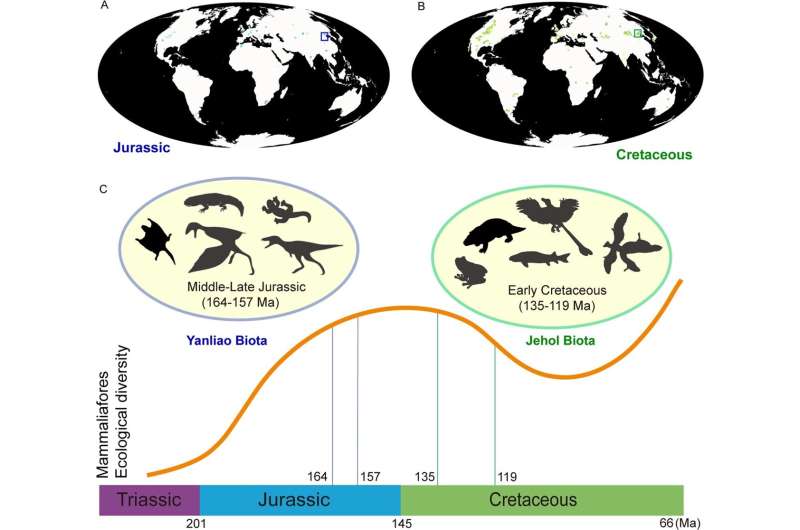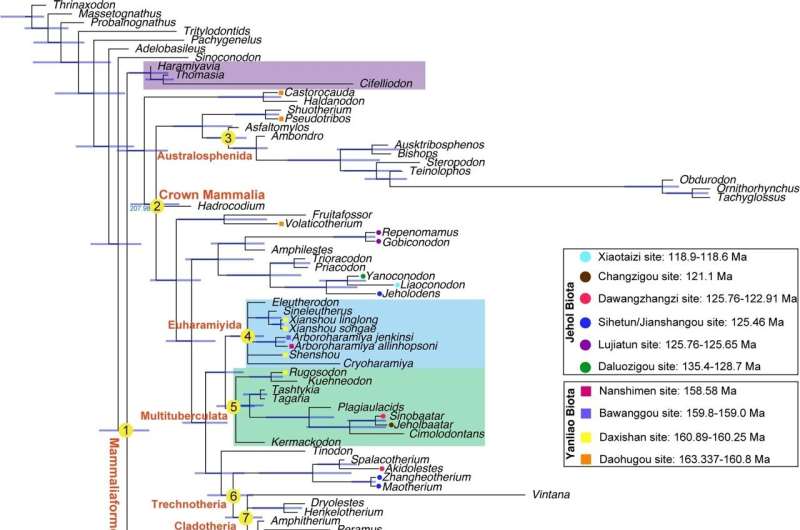June 19, 2023 feature
This article has been reviewed according to Science X's editorial process and policies. Editors have highlighted the following attributes while ensuring the content's credibility:
fact-checked
peer-reviewed publication
trusted source
proofread
China's Yanliao Biota offers a new window into mammal evolution since the Triassic

China's Yanliao Biota, an assembly of fossils preserved in northeastern China dating from the Middle to Late Jurassic (174 to 145 million years ago), offers an important window into the evolution of vertebrates. With exceptional preservation of insects, feathered dinosaurs and transitional pterosaurs, plus early representatives of salamanders and mammals, the biota is known as a Lagerstätte.
Understating the timing of the evolutionary events during these periods is vital to discovering the diversification of life through time, and scientists have now used volcanic layers of ash, known as tuff, to date the fossil-bearing units, as reported in Earth and Planetary Science Letters.
Creating an artificially exposed cave in sedimentary rocks that were deposited in a lacustrine environment (associated with a lake), the sites were located in the Liaoning and Hebei Provinces in the northeast of China. The ash fell into the lake during a volcanic eruption and was not subsequently moved, which is important, as it means scientists know these layers can help date the fossils with greater precision.
Researchers at the Institute of Vertebrate Paleontology and Paleoanthropology, China, and their collaborators used a technique called cathodoluminescence. This involves polishing grains of a crystal, exposing the center and using a special microscope to view them. This microscope uses light to reveal particular characteristics of the crystal, while cathodoluminescence benefits from two parts of an atom—electrons being fired at the grain and the resulting luminescence causing the emission of photons at different wavelengths. As the crystals were almost pristine, the researchers know they were not transported from their original location.
These sedimentary layers were dated using 129 grains of a crystal called zircon, from which the levels of uranium, thorium and lead were measured. This is known as U-Pb radiometric dating, and uses the principle that uranium decays over time into a more stable form, this being lead. The time taken for uranium to decay by half is known as its half life, and this is important for science, as radioactive elements have known half lives that can be used to determine how many have occurred since the element was formed. For example, there are two types of uranium, known as isotopes, that are used for radiometric dating—uranium-238 has a half life of 4.5 billion years, while uranium-235 has a half life of 704 million years. Based upon this, the researchers have dated the Yanliao Biota to between 164 and 157 million years old.

Within the sections sampled, six salamanders were discovered, which were dated to 164 million years. The researchers state that this represents one of the earliest diversification events of Caudata, a group of amphibians. Membrane-winged dinosaurs were found in sedimentary rocks dating to 164 to 160 million years, which coincides with previous studies on the development of flight in theropod dinosaurs, of which the scansoriopterygids found here are the earliest gliding flyers. Euharamiyidans, some of the earliest mammal ancestors, were dated to units aged 163 to 158 million years.
This information was used in a technique known as Bayesian tip-dated phylogeny to constrain the origin date of true mammals prior to these early mammal ancestors. Software was used to create what is essentially a complex "family tree," whereby those with similar characteristics are found closer together and evolutionary patterns can be seen.
The researchers identified the root of mammalian evolution back into the Late Triassic (208 million years ago), spawning diversification in the Jurassic. This is known as the long-fuse model, and has been subject to debate as some researchers have advocated for the explosive model, in which early mammals originated in the Middle Jurassic before rapidly diversifying. Though the researchers support the long-fuse model, they stress that there was a delay in diversification until the Middle Jurassic, so there are likely more ghost lineages of hypothesized mammal ancestors to be found as researchers continue to explore the wonders of life on Earth in the deep past.
More information: Zhiqiang Yu et al, Temporal framework for the Yanliao Biota and timing of the origin of crown mammals, Earth and Planetary Science Letters (2023). DOI: 10.1016/j.epsl.2023.118246
Journal information: Earth and Planetary Science Letters
© 2023 Science X Network





















